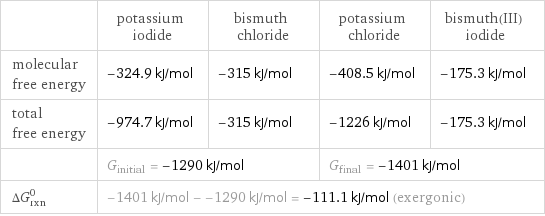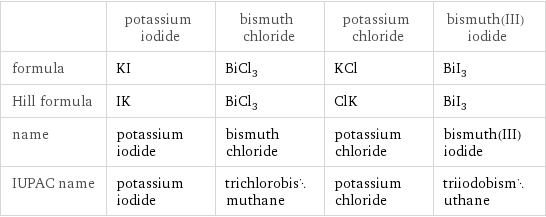Input interpretation

KI potassium iodide + BiCl_3 bismuth chloride ⟶ KCl potassium chloride + BiI_3 bismuth(III) iodide
Balanced equation

Balance the chemical equation algebraically: KI + BiCl_3 ⟶ KCl + BiI_3 Add stoichiometric coefficients, c_i, to the reactants and products: c_1 KI + c_2 BiCl_3 ⟶ c_3 KCl + c_4 BiI_3 Set the number of atoms in the reactants equal to the number of atoms in the products for I, K, Bi and Cl: I: | c_1 = 3 c_4 K: | c_1 = c_3 Bi: | c_2 = c_4 Cl: | 3 c_2 = c_3 Since the coefficients are relative quantities and underdetermined, choose a coefficient to set arbitrarily. To keep the coefficients small, the arbitrary value is ordinarily one. For instance, set c_2 = 1 and solve the system of equations for the remaining coefficients: c_1 = 3 c_2 = 1 c_3 = 3 c_4 = 1 Substitute the coefficients into the chemical reaction to obtain the balanced equation: Answer: | | 3 KI + BiCl_3 ⟶ 3 KCl + BiI_3
Structures

+ ⟶ +
Names

potassium iodide + bismuth chloride ⟶ potassium chloride + bismuth(III) iodide
Reaction thermodynamics
Gibbs free energy

| potassium iodide | bismuth chloride | potassium chloride | bismuth(III) iodide molecular free energy | -324.9 kJ/mol | -315 kJ/mol | -408.5 kJ/mol | -175.3 kJ/mol total free energy | -974.7 kJ/mol | -315 kJ/mol | -1226 kJ/mol | -175.3 kJ/mol | G_initial = -1290 kJ/mol | | G_final = -1401 kJ/mol | ΔG_rxn^0 | -1401 kJ/mol - -1290 kJ/mol = -111.1 kJ/mol (exergonic) | | |
Equilibrium constant
![Construct the equilibrium constant, K, expression for: KI + BiCl_3 ⟶ KCl + BiI_3 Plan: • Balance the chemical equation. • Determine the stoichiometric numbers. • Assemble the activity expression for each chemical species. • Use the activity expressions to build the equilibrium constant expression. Write the balanced chemical equation: 3 KI + BiCl_3 ⟶ 3 KCl + BiI_3 Assign stoichiometric numbers, ν_i, using the stoichiometric coefficients, c_i, from the balanced chemical equation in the following manner: ν_i = -c_i for reactants and ν_i = c_i for products: chemical species | c_i | ν_i KI | 3 | -3 BiCl_3 | 1 | -1 KCl | 3 | 3 BiI_3 | 1 | 1 Assemble the activity expressions accounting for the state of matter and ν_i: chemical species | c_i | ν_i | activity expression KI | 3 | -3 | ([KI])^(-3) BiCl_3 | 1 | -1 | ([BiCl3])^(-1) KCl | 3 | 3 | ([KCl])^3 BiI_3 | 1 | 1 | [BiI3] The equilibrium constant symbol in the concentration basis is: K_c Mulitply the activity expressions to arrive at the K_c expression: Answer: | | K_c = ([KI])^(-3) ([BiCl3])^(-1) ([KCl])^3 [BiI3] = (([KCl])^3 [BiI3])/(([KI])^3 [BiCl3])](../image_source/58b1b32ca32cb2dba778ed2770edef92.png)
Construct the equilibrium constant, K, expression for: KI + BiCl_3 ⟶ KCl + BiI_3 Plan: • Balance the chemical equation. • Determine the stoichiometric numbers. • Assemble the activity expression for each chemical species. • Use the activity expressions to build the equilibrium constant expression. Write the balanced chemical equation: 3 KI + BiCl_3 ⟶ 3 KCl + BiI_3 Assign stoichiometric numbers, ν_i, using the stoichiometric coefficients, c_i, from the balanced chemical equation in the following manner: ν_i = -c_i for reactants and ν_i = c_i for products: chemical species | c_i | ν_i KI | 3 | -3 BiCl_3 | 1 | -1 KCl | 3 | 3 BiI_3 | 1 | 1 Assemble the activity expressions accounting for the state of matter and ν_i: chemical species | c_i | ν_i | activity expression KI | 3 | -3 | ([KI])^(-3) BiCl_3 | 1 | -1 | ([BiCl3])^(-1) KCl | 3 | 3 | ([KCl])^3 BiI_3 | 1 | 1 | [BiI3] The equilibrium constant symbol in the concentration basis is: K_c Mulitply the activity expressions to arrive at the K_c expression: Answer: | | K_c = ([KI])^(-3) ([BiCl3])^(-1) ([KCl])^3 [BiI3] = (([KCl])^3 [BiI3])/(([KI])^3 [BiCl3])
Rate of reaction
![Construct the rate of reaction expression for: KI + BiCl_3 ⟶ KCl + BiI_3 Plan: • Balance the chemical equation. • Determine the stoichiometric numbers. • Assemble the rate term for each chemical species. • Write the rate of reaction expression. Write the balanced chemical equation: 3 KI + BiCl_3 ⟶ 3 KCl + BiI_3 Assign stoichiometric numbers, ν_i, using the stoichiometric coefficients, c_i, from the balanced chemical equation in the following manner: ν_i = -c_i for reactants and ν_i = c_i for products: chemical species | c_i | ν_i KI | 3 | -3 BiCl_3 | 1 | -1 KCl | 3 | 3 BiI_3 | 1 | 1 The rate term for each chemical species, B_i, is 1/ν_i(Δ[B_i])/(Δt) where [B_i] is the amount concentration and t is time: chemical species | c_i | ν_i | rate term KI | 3 | -3 | -1/3 (Δ[KI])/(Δt) BiCl_3 | 1 | -1 | -(Δ[BiCl3])/(Δt) KCl | 3 | 3 | 1/3 (Δ[KCl])/(Δt) BiI_3 | 1 | 1 | (Δ[BiI3])/(Δt) (for infinitesimal rate of change, replace Δ with d) Set the rate terms equal to each other to arrive at the rate expression: Answer: | | rate = -1/3 (Δ[KI])/(Δt) = -(Δ[BiCl3])/(Δt) = 1/3 (Δ[KCl])/(Δt) = (Δ[BiI3])/(Δt) (assuming constant volume and no accumulation of intermediates or side products)](../image_source/15f997010e8788c1c2e3ec9e11e9d53a.png)
Construct the rate of reaction expression for: KI + BiCl_3 ⟶ KCl + BiI_3 Plan: • Balance the chemical equation. • Determine the stoichiometric numbers. • Assemble the rate term for each chemical species. • Write the rate of reaction expression. Write the balanced chemical equation: 3 KI + BiCl_3 ⟶ 3 KCl + BiI_3 Assign stoichiometric numbers, ν_i, using the stoichiometric coefficients, c_i, from the balanced chemical equation in the following manner: ν_i = -c_i for reactants and ν_i = c_i for products: chemical species | c_i | ν_i KI | 3 | -3 BiCl_3 | 1 | -1 KCl | 3 | 3 BiI_3 | 1 | 1 The rate term for each chemical species, B_i, is 1/ν_i(Δ[B_i])/(Δt) where [B_i] is the amount concentration and t is time: chemical species | c_i | ν_i | rate term KI | 3 | -3 | -1/3 (Δ[KI])/(Δt) BiCl_3 | 1 | -1 | -(Δ[BiCl3])/(Δt) KCl | 3 | 3 | 1/3 (Δ[KCl])/(Δt) BiI_3 | 1 | 1 | (Δ[BiI3])/(Δt) (for infinitesimal rate of change, replace Δ with d) Set the rate terms equal to each other to arrive at the rate expression: Answer: | | rate = -1/3 (Δ[KI])/(Δt) = -(Δ[BiCl3])/(Δt) = 1/3 (Δ[KCl])/(Δt) = (Δ[BiI3])/(Δt) (assuming constant volume and no accumulation of intermediates or side products)
Chemical names and formulas

| potassium iodide | bismuth chloride | potassium chloride | bismuth(III) iodide formula | KI | BiCl_3 | KCl | BiI_3 Hill formula | IK | BiCl_3 | ClK | BiI_3 name | potassium iodide | bismuth chloride | potassium chloride | bismuth(III) iodide IUPAC name | potassium iodide | trichlorobismuthane | potassium chloride | triiodobismuthane
Substance properties

| potassium iodide | bismuth chloride | potassium chloride | bismuth(III) iodide molar mass | 166.0028 g/mol | 315.3 g/mol | 74.55 g/mol | 589.69381 g/mol phase | solid (at STP) | solid (at STP) | solid (at STP) | solid (at STP) melting point | 681 °C | 231 °C | 770 °C | 408 °C boiling point | 1330 °C | 447 °C | 1420 °C | density | 3.123 g/cm^3 | 4.75 g/cm^3 | 1.98 g/cm^3 | 5.78 g/cm^3 solubility in water | | | soluble | dynamic viscosity | 0.0010227 Pa s (at 732.9 °C) | 41 Pa s (at 25 °C) | | odor | | | odorless |
Units
